The Lady Conceta face powder box was a lucky find (an antiques mall), and I believe that it dates from the late 1920s to the early 1930s.
Whenever I attempt to date a face powder box that has no manufacturer information on it there are a couple of preliminary steps that I will take. I’ll look at the back of the box, because sometimes the font used in describing the contents can be a clue to the era. The Spanish shawl which is draped so charmingly over the woman’s arm with the design spilling onto the sides of the box is what made me think of the 1920s/1930s.
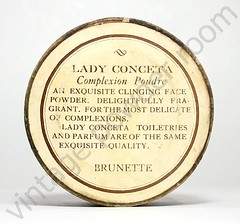 It’s also helpful to have a general knowledge of popular culture during different decades because the graphics on the box very often reflect popular themes of a specific era. Spanish shawls were a popular fashion accessory during that period. I’ve seen them in old films and photographs; although I’ve never been able to make a distinction between a Spanish shawl as an accessory, and the virtually identical piano shawl (also popular during the 20s and 30s) which was used to protect the top of a piano from scratches. They may have been one and the same (if anyone knows for sure, drop me a note).
It’s also helpful to have a general knowledge of popular culture during different decades because the graphics on the box very often reflect popular themes of a specific era. Spanish shawls were a popular fashion accessory during that period. I’ve seen them in old films and photographs; although I’ve never been able to make a distinction between a Spanish shawl as an accessory, and the virtually identical piano shawl (also popular during the 20s and 30s) which was used to protect the top of a piano from scratches. They may have been one and the same (if anyone knows for sure, drop me a note).
Another popular culture clue in dating the Lady Conceta box was the woman depicted in the design. During the silent movie era the screen was often dominated by exotic looking men (e.g. Rudolph Valentino, Ramon Novarro) and women. Of the women working in film during those years two came to mind: Delores del Rio and Lupe Velez. The woman on the box seemed to me to be Lupe.
Lupe was born Maria Guadalupe Velez de Villalobos on July 18, 1908 in San Luis Potosi, Mexico. Her father was an army officer, and her mother was an opera singer. Lupe was educated in a convent in Texas, however she once said in an interview “But can you imagine a girl like me – all the time so happy – in a convent?” She found her calling and a place for her manic energy, when she first appeared at the Teatro Principal as a teenager. She was lovely, vivacious, and she wowed audiences in Mexico City.
When Lupe arrived in Hollywood in 1927 she was spotted by Hal Roach who cast her in a Laurel & Hardy comedy. She’d made an impression, and was selected as one of the WAMPAS “baby” stars in 1928. Even though Lupe’s big break would be in a dramatic role in “The Gaucho“, co-starring Douglas Fairbanks, Lupe had a flair for comedy. In 1933 she made the switch to comedy full-time. She won the role of Pepper in “Hot Pepper” and she would shine.

Lupe’s role in “Hot Pepper” provided her an easy segue into the “Mexican Spitfire” films. The Spitfire series was written specifically for Lupe to showcase her talent as a comedic actress. Lupe’s exuberance and sparkle would draw audiences to her. Of course it didn’t hurt that she was as madcap off screen as on.
 Nearly every article written about Lupe described her as fiery, tempestuous, and the petite star did have a volatile personality. She was once at an airport, ready to board a flight, when she realized that her tickets had gone missing. She hurled her hat, handbag, and gloves to the tarmac and proceeded to stomp her hat into a pulp.
Nearly every article written about Lupe described her as fiery, tempestuous, and the petite star did have a volatile personality. She was once at an airport, ready to board a flight, when she realized that her tickets had gone missing. She hurled her hat, handbag, and gloves to the tarmac and proceeded to stomp her hat into a pulp.
Her affairs were legendary, and she always had something provocotive to say about love. Her most famous quote is: “The first time you buy a house you think how pretty it is and sign the check. The second time you look to see if the basement has termites. It’s the same with men.”
She had a well publicized Hollywood romance with Gary Cooper in the late 1920s, but when it blew up the two bickered and took potshots at each other in the press. About Gary, Lupe said that he may have been an idol to his mother, but that to her he was less than nothing. The statement lends credibility to the rumor that the relationship was torpedoed by Cooper’s mom.
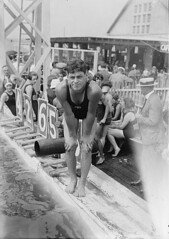 By early 1933 she was linked with Olympic champion swimmer, and star of “Tarzan, the Ape Man”, Johnny Weissmuller. On January 12th of that year she was quoted in the Los Angeles Times explaining that “Love is not for such as me, and anyone who says I am in love with Johnny Weissmuller is crazy”. It turned out that the rumors were true. Lupe and Johnny were married ten months later.
By early 1933 she was linked with Olympic champion swimmer, and star of “Tarzan, the Ape Man”, Johnny Weissmuller. On January 12th of that year she was quoted in the Los Angeles Times explaining that “Love is not for such as me, and anyone who says I am in love with Johnny Weissmuller is crazy”. It turned out that the rumors were true. Lupe and Johnny were married ten months later.
All of Lupe’s relationships seemed to have been turbulent on and off again affairs – and her marriage to Weissmuller would be no different. On August 13, 1938 the Los Angeles Times suggested that if only Weissmuller had “confined his warfare on the animal kingdom to tying knots in the tail of Numa the lion” perhaps his marriage to Velez wouldn’t have been on the rocks. During their divorce hearing in 1939, Lupe told the judge that “Johnee wanted to kill my little dog”. According to her Weissmuller would scare her Chihuahua so badly that it would turn tail and run, yipping, to hide in her lap.
A few years following her divorce Lupe became involved with French film actor Harald Ramond Marecsh. By Thanksgiving 1944 local newspapers were reporting that the two planned to wed. Only a couple of weeks later, on December 14th, Lupe Velez would be dead by her own hand.
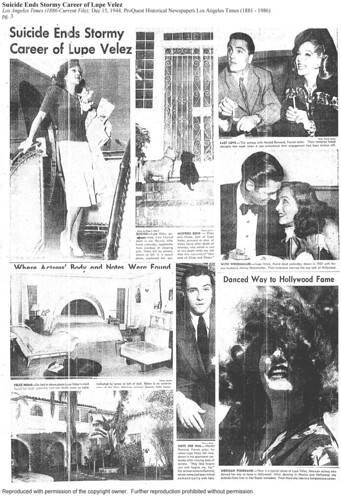 Lupe was pregnant with Harald’s child, and he was very reluctant to get married. It may have been his suggestion of a mock marriage that pushed Lupe over the edge. The note she left for him (which was reprinted in full in the papers) said as much. She wrote: “How could you Harald, fake such great love for me and our baby when all along you didn’t want us”.
Lupe was pregnant with Harald’s child, and he was very reluctant to get married. It may have been his suggestion of a mock marriage that pushed Lupe over the edge. The note she left for him (which was reprinted in full in the papers) said as much. She wrote: “How could you Harald, fake such great love for me and our baby when all along you didn’t want us”.
Lupe carefully staged her final scene in her home on Rodeo Drive in Beverly Hills. She was discovered by her maid “sleeping peacefully” in her all white boudoir, on ivory satin sheets, wearing blue silk pajamas. On the nightstand was an empty bottle of Seconal and two notes, one for Harald and one for her secretary.
A rumor has persisted for years that Lupe didn’t die of a barbiturate overdose and that instead she was feeling very sick after ingesting the Seconal, got up out of bed and went into the bathroom where she stuck her head in the toilet to vomit and subsequently died by drowning. I’ve never found any credible source for that story.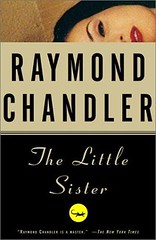
When I think of Lupe I remember the life and energy that radiated from her in her films, and in the interviews that she gave. While re-reading Raymond Chandler’s great novel, “The Little Sister” I’ve found a character who seems like a deviant twist on Lupe’s public persona. The woman in the novel is Dolores Gonzales. Like Lupe she’s vibrant and sensual; but unlike Lupe she puts on a phoney accent and hails from Cleveland, Ohio. And Dolores is a very a bad dame.
One side note — I think that the woman on the cover of the Black Lizard trade paperback edition of “The Little Sister” is burlesque queen Dita von Teese. Anyone agree with me?
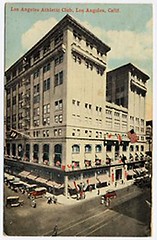
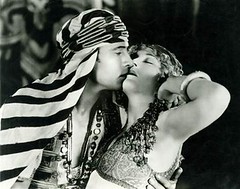 The Los Angeles Athletic Club has generously offered Casino Night attendees a discounted room in their historic hotel for $134.00. Rate includes American Buffet Breakfast in the third floor Grill Room, in-room WiFi, use of the Athletic Facility and discount overnight parking of $12.00/car. Not included is the city occupancy tax, currently 14%. Call 1-800-421-8777 to book your room.
The Los Angeles Athletic Club has generously offered Casino Night attendees a discounted room in their historic hotel for $134.00. Rate includes American Buffet Breakfast in the third floor Grill Room, in-room WiFi, use of the Athletic Facility and discount overnight parking of $12.00/car. Not included is the city occupancy tax, currently 14%. Call 1-800-421-8777 to book your room.
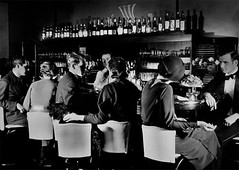

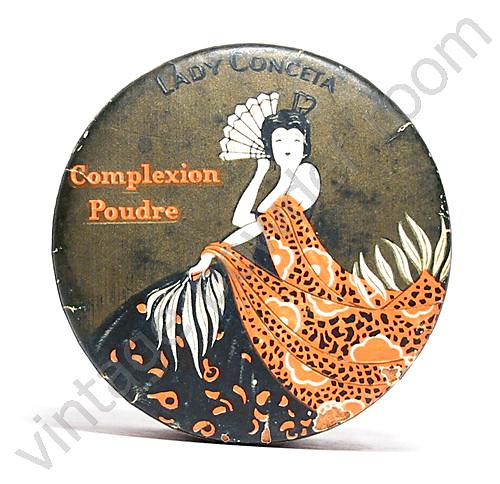

 It’s also helpful to have a general knowledge of popular culture during different decades because the graphics on the box very often reflect popular themes of a specific era.
It’s also helpful to have a general knowledge of popular culture during different decades because the graphics on the box very often reflect popular themes of a specific era.


 By early 1933 she was linked with Olympic champion swimmer, and star of “Tarzan, the Ape Man”, Johnny Weissmuller. On January 12th of that year she was quoted in the Los Angeles Times explaining that “Love is not for such as me, and anyone who says I am in love with Johnny Weissmuller is crazy”. It turned out that the rumors were true. Lupe and Johnny were married ten months later.
By early 1933 she was linked with Olympic champion swimmer, and star of “Tarzan, the Ape Man”, Johnny Weissmuller. On January 12th of that year she was quoted in the Los Angeles Times explaining that “Love is not for such as me, and anyone who says I am in love with Johnny Weissmuller is crazy”. It turned out that the rumors were true. Lupe and Johnny were married ten months later.
 Lupe was pregnant with Harald’s child, and he was very reluctant to get married. It may have been his suggestion of a mock marriage that pushed Lupe over the edge. The note she left for him (which was reprinted in full in the papers) said as much. She wrote: “How could you Harald, fake such great love for me and our baby when all along you didn’t want us”.
Lupe was pregnant with Harald’s child, and he was very reluctant to get married. It may have been his suggestion of a mock marriage that pushed Lupe over the edge. The note she left for him (which was reprinted in full in the papers) said as much. She wrote: “How could you Harald, fake such great love for me and our baby when all along you didn’t want us”.

